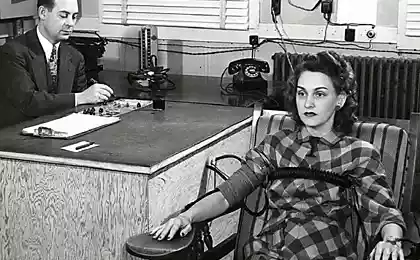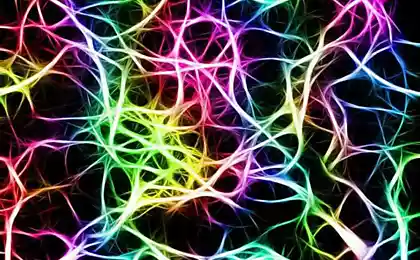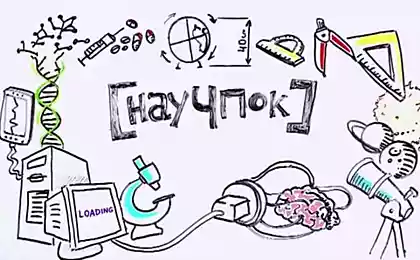669
Michael Shermer: the pattern behind self-deception
Michael Shermer argues that the human tendency to believe in amazing things — from alien abductions to the vines to search for water — boils down to two main unconscious instincts of self-preservation. He explains what they are and how this brought us to disaster.

https://embed-ssl.ted.com/talks/lang/ru/michael_shermer_the_pattern_behind_self_deception.html
SUBSCRIBE to OUR youtube channel that allows you to watch online, download from YouTube free video about the recovery, the rejuvenation of man. Love for others and ourselves, as the feeling of high vibrations — an important factor
0:12
Since my last appearance on this stage in 2006, it was found that the change in the Earth's climate, it seems, is quite a serious problem. And we discussed this topic in great detail in the journal Skeptic. We have studied all the scientific and pseudo-scientific debate concerning this issue. But it turns out we don't have to concern about these facts, because still in 2012 come to an end.
0:32
In other news: Remember I showed you the Quadro Tracker is something like a device for finding water is essentially a piece of plastic to which is attached a spinning back antenna. When moving, it points to different things. For example, if you're looking for marijuana in students ' lockers, it'll point right to... Oops, sorry (laughter) But this thing was given to me finds Golf balls especially if you're on a Golf course and combing the space under every Bush. So, what's the harm of silly stuff like this? Consider the ADE 651 device, which was sold to the Iraqi government for 40 thousand dollars apiece and it's a completely useless thing is the same as the one in my hands and supposedly works on the principle of "electrostatic magnetic ion attraction" which translated into Russian is a kind of more specific to say... "pseudoscientific bullshit"phrase from the heap of clever words put together have no meaning In this case the device was used to test people and allowed passage by showing that everything is in order, and the evidence of the cost of human lives. As we see, the pseudoscience can be dangerous, causing us to believe in such things.
1:45
So today I want to talk about faith. I want to believe... And You too, of course. And in fact, I would argue that in order to believe in something. It is the default option. We just believe. We believe in very different things to Believe of course. Distrust, skepticism, science — protivoestvennymi phenomenon. They are much more difficult. Not to believe in something for us is not convenient.So like Fox Mulder from x-files who wants to believe in UFOs, and so do we.And the reason for this is that in our mind is the motor of the faith so basically we are primates who are committed to finding samples, templates, we build a logical relationship between the elements: A linked to B B linked to C and sometimes A really is connected to B Is called associative thinking
2:30
We find the matching templates. We create these ties. Whether it is Pavlov's dog who associates the ringing bell with food and starts drooling when he heard it. Or a rat Skinner, which is imposed on the Association between its behavior and receive the promotion, with the result that it behaves as in previous times. In fact, Skinner showed that if you put a pigeon in a similar cage in which he has to press one of these buttons is trying to detect a pattern, following which he will receive a small reward in the box If you just give the promotion in a random way, i.e., without any system, whatever the line will still be found. And will repeat those actions that they made before getting a reward. Sometimes it was even spinning around twice counterclockwise, once clockwise and twice peck the button. And that's called superstition. And that's what I'm afraid will always have with us.
3:22
I call this process "stereotyping", it has a tendency to look for patterns everywhere — and where they are, and meaningless noise. In the process of the search may be two types of errors. A type I error — a false positive When we consider that a pattern exists when in fact it is not. The second type of error is the omission of the events of the second type of Error is the rejection of the real existing pattern. Let's do a thought experiment.Imagine, three million years ago, you're a hominid walking on the plains of Africa. Well, your name is Lucy, okay? And you hear a rustle in the grass. What is it? Dangerous predator or just the wind? Your next decision may be the most important in life. If you think that the rustle in the grass is a dangerous predator and it turns out it was just the wind, then you have made a recognition error, made an error of the first kind — false positive. Nothing to worry about. You just went from there. You're more cautious. On the other hand, if you thought it was just the wind, but in reality it is a dangerous predator, you're lunch. Won the Darwin award. Took a contribution from the human gene pool.
4:27Фишка that stereotyping occurs only when the price of committing errors of the first kind less than the cost of making errors of the second kind. By the way, this is the only equation in the talk. The definition of the behavior pattern - assessment of the difference between the error of the first and the second kind is an extremely difficult task especially when the decision should take a moment. in situations in which the issue of life and death. Therefore, the default position is simply "to believe that all patterns are "All rustles in the grass are dangerous, hisnike not the wind" And I think that we evolved... was a natural selection for the propensity to believe in those whose brain looking for hard matching, so I always cross reference and associate them with any predatory or intentional agencies, and to this thought I will return.
5:10
Well, for example, what do you see here? The horse's head, right. It looks like a horse. It must be a horse. It's a stereotype. Is it true that a horse? Or maybe a frog? See our staff to identify patterns which, incidentally, is located in the anterior cingulate cortex is our smallest determinant - can be easily deceived and it is a problem for Example, what do you see here? Well, of course. This is a cow. Once I Prime the brain -- it's called cognitive priming -- once I Prime the brain this unidetified back out again even without the pattern that I tied. What you see here? Some people see a Dalmatian dog. Yes, this is it. And that's priming. And when I go back without the seed, your brain already has the model and I'll be able to see the same thing. What you see here? The Planet Saturn. Well. And here? Just shout out anything you see. That's a good audience, Chris. Because there's nothing. That is to say, there's nothing there.
6:15
Jennifer Whitson conducted an experiment at the University of Texas in Austin in a corporate environment, which was designed to determine whether people make sense of uncertainty and uncontrollability to see the illusory matching. That is, almost all see the planet Saturn. But people placed in environments where they feel out of control are more likely to see something here, where nothing is ordered there. In other words, the propensity to find these patterns increases with uncontrollable life situations. For example, it is well known that baseball players behave "superstitious" when they are served and this behavior weakens when a player in the field. Because fielders are successful 90 to 95 percent of the time. The best batters fail seven times out of ten So all of their stereotypicalness and Ghost fear arises in uncontrolled situations and other similar cases.
7:06Что you see here in this picture? Does anybody see here any subject? Actually there is something, but muffled. While you think it is, will tell you about an experiment done by Susan Blackmore, a psychologist from England, who showed subjects these muted images and then conducted a correlation between their performance on the ESP scale, which shows how people believe in the paranormal, supernatural, angels and so on. And those who scored high on the ESP scale, tended not only to see more images in the singular pictures, but to see fake images. That's what's shown Fish muted for 20 protsenotov, 50 percent and one that I showed you, 70 percent.
7:50
A similar experiment was made by another Swiss psychologist named Peter Bruggenkate found that significantly more meaningful images perceived by the right hemisphere via the left visual field, than the left hemisphere. So when you show such subjects of the picture, which will go to the right hemisphere instead of the left, they are likely to see where images than those that are perceived by the left hemisphere. Our right hemisphere appears to be responsible for stereotyping. So, we are trying to infiltrate into the brain to see where it all happens.
8:19
Brugger and his colleague, Christine Mohr, gave subjects l-DOPA. Levodopa is, you know, a drug for the treatment of Parkinson's disease, which is related to a decrease in dopamine. Levodopa increases dopamine levels. And the increase in the level of dopamine led to the fact that subjects to see more patterns than those that did not receive the dopamine. So it seems that dopamine is associated with stereotyping. In fact, neuroleptic drugs that are used to eliminate psychotic behavior, things like paranoia, delusions and hallucinations, at the heart of each of which is stereotyping. In these States people incorrect patterns. They're false positives. Errors of the first kind. But if you give them drugs that are dopamine antagonistami, these visions will disappear. Thus, with increasing amounts of dopamine, their tendency to see patterns like that decreases. On the other hand, amphetamines like kakainavaya dopamine agonists. They increase his level. Therefore, in a state of euphoria, you're more likely to feel a burst of creativity, to see more images.
9:19
In fact, I recently saw Robin Williams who said that he was much funnier when he was doing cocaine than it is now. So perhaps dopamine is associated with more creativity. Dopamine, I think, changes the ratio signal/noise in the perceived information. That is how accurate we are in defining images. If it's too low, you're more likely to make a lot of errors of the second kind. You miss the real patterns. You don't want to be too skeptical. If you're too skeptical, you'll miss the really interesting good ideas. You have to be creative, but don't fall for bullshit. Too high and maybe you see patterns everywhere. Every time somebody looks at you, he feels that people are staring. It seems that people are talking about. And if he goes too far on that, that's just called crazy. This distinction we can make between two Nobel laureates, Richard Feynman and John Nash. One sees exactly the amount of images, which is enough to win a Nobel prize. The second, too, perhaps too much. And we call it schizophrenia.
10:17
Thus, the determination of the ratio signal/noise is the task of identifying a pattern. And, of course, you know exactly what that is, right? What image do you see here? Again, here I'm testing the anterior cingulate cortex of your brain and cause conflict in the definition of the correspondences. Of course, you know that this shoes Via Uno sandals. Stunning legs, I must say. Maybe a little photoshopped. And, of course, excess outlines, which seem to oscillate back and forth. It turns out that what you think a lot influences what you tend to see. And here you can see the light I know. Because the light was on. Of course, due to the movement of environmentalists we're all sensitive to the plight of marine mammals. So what you see in this picture is unclear, of course, dolphins. right. It's a Dolphin. And here's a Dolphin And there's a Dolphin. Guys, is the tail of a Dolphin.
11:16
(Laughter)
11:21
Again, if you conflicting data, the anterior cingulate cortex of your brain comes to a screeching halt. If you look down here, it's all good. If you look up here, then there is a conflict. And when we turn the picture, you'll see that it's an illusion. The impossible crate illusion. To trick the brain when considering planar images easily. So what do you say, "aw, come on Shermer, anybody as old as the world." Okay, here's a photo of the great Jerry Andrews which was a re-focus in 3D. That Jerry is standing inside the impossible box. He's a good guy, so I posted this picture with the clue. Of course, it all depends on the camera position. The photographer is over there. And it turns out that this face effect on this, and there is another, and so on. But even when I already know that the illusion is due to the fact that our mostappropriate to find such images.
12:10
This is a fairly new example of how we come to a screeching halt due to the conflict patterns of comparing this angle with this. Actually, there's two identical images. We here compare this angle with that instead of here. And your brain is fooled. Again your devices to determine correspondences fooled.
12:28Мы can easily see the subjects face, because in the process of evolution we have powerassetmonitor program for recognition of individuals in our temporal lobes. Here are some of the face stones. I'm not even sure that they exist. Maybe it's photoshop. But it doesn't matter.Now which of these images looks strange? The one on the left. Left. Okay. So I'll rotate and it will be on the right. And you're right. A fairly famous illusion — the first was with Margaret Thatcher. Now its all the time do the politicians. So why is this happening? Well, we know exactly where this occurs in the temporal lobe, just above your ear there. In a little structure called the fusiform gyrus. And there are two types of cells that do this some will remember the faces in General, and other private details. Large rapid-cells - work at the first glance at a person and determine common features. So you immediately know Obama. And then you notice something strange about the eyes and mouth. Especially when they are turned upside down, activated the facial recognition in General.
13:30
Now back to our little thought experiment. You're a hominid walking on the plains of Africa. If there is wind or a dangerous predator? What's the difference? Indeed, the wind is inanimate; the dangerous predator is an object that is able to action. And I call this process giving the ability to act. This is a trend to endow images with meaning, but also the ability to directional action applied to the often invisible beings from the top. Here's an idea that has occurred to our friend, who also spoke at TED, Dan Dennet, who spoke about the position of the action.
13:59
It is something similar, but expanded in order to help explain the existence of many phenomena of spirits, ghosts, gods, demons, angels, aliens, the theory of intelligent design, conspiracy theories and all unseen endowed with intentions who came into our world to rule our lives. I think it's the basis of animism and polytheism and monotheism.Faith in the fact that the aliens we developed stronger and more moral. And the source of all these stories that they will come and save us from something higher. Supporters of the creation of intelligent force always portrayed her as megaintellektualnyh moral sozdaniemnovogo comes down to design life. And even the idea that the government can save us. This is no longer an unshakable trend. But it is a type endowed with the ability to function, creating an image of someone higher, big and strong, who came to save us.
14:46
It is also the premise of the conspiracy theories That someone invisible was pulling the strings, whether it be the Illuminati or Bilderberg group members. But all these things belong to the pattern detection problem, isn't it. Some images actually exist, others do not. Was JFK assassinated by a conspiracy or by a lone assassin? If you go there — is there any day there are specially trained people - for example, when I went there, here -- showing me where the different shooters were. My favorite, which was in the manhole. And he popped up at the last moment and shot. But on the other hand, the Lincoln assassination was a conspiracy.So we can't just write off like that. Because, let's face it, some patterns are real. Some conspiracies are real. And it explains a lot.
15:28
And there's a theory that 9/11 was the result of a conspiracy. And this is the plot. We have a whole issue. 19 members of al Queda plotting to fly planes into stanjamescasino is a conspiracy. But that's not what I think supporters of uncovering the truth about the events of 9/11 They believe that it was a conspiracy of the Bush administration. In fact, it is a topic for another lecture. But, you know, how we know that 9/11 was not orchestrated by the Bush administration? Because it worked.
15:50
(Laughter)
15:53
(Applause)
15:56
So we are natural-born dualists. And our tendency to endow objects with the ability to act stems from the fact that we like similar movies. Because we can, in essence, prodolet to invent. We know that stimulating the temporal lobe can cause a feeling of being outside of the body separating the astral body from the physical body, and all this can be achieved by just touching an electrode to the temporal lobe there. Well, or loss of consciousness due to being in a centrifuge. Or because of hypoxia, low oxygen levels. The brain becomes out-of-body experience. You can also use = what I did -Divine Helmet Michael Persinger that bombards your temporal lobes with electromagnetic waves. And it also causes out-of-body experience.
16:35
I'm going to finish watching the short video clip that will bring all this together. Only a minute and a half. It demonstrates the communication power of expectation and the power of faith.Let's start.
16:46
Narrator: this is the location they chose for their fake auditions for an advert for lip balm.
16:51
Woman: We hope we will be able to use it in the ad that will show across the country. And this is test on some lip balms that we have here. And here is our model-assistants, Roger and Matt. We have a copy of our lip balm, as well as one of the leading manufacturers. Would you have any problem kissing our models to test it?
17:11
Girl: No.
17:13
Woman: No? (Girl: No.) Woman: That would be fine.
17:15
Girl: Yeah, absolutely. (Woman: Okay.)
17:17
So this is a blind test. So I will ask you to wear a blindfold. Okay, now can you see anything? (Girl: No.) Pull it so you couldn't even see down. (Girl: Okay.)
17:30
Woman: Now you absolutely do not see anything, right?
17:32
Girl: Yes. (Woman: Okay.)
17:34
So, in this test I will study how the balm protects your lips, the texture, and maybe you can discern any odors.
17:45
Girl: Okay. (Woman: have You ever done a kissing test before?)
17:48
Girl: No.
17:50
Woman: come here. Okay, now pull your lips in for a kiss. Pucker up big and lean slightly forward.
18:02
(♪♫♪)
18:06
(Laughter)
18:15
(Laughter)
18:26
OK. Jennifer, how is it?
18:3
Jennifer: All Right.
18:32
(Laughter)
18:39
Girl: Oh My God!
18:41
(Laughter)
18:46
Michael Shermer: Thank you. Thank you.published
Timothy Leary: What will the neighbours say? — here is the beginning and end of modern psychology
Sergei Kapitsa: How to teach — knowledge or understanding?
Put LIKES and share with your FRIENDS!
www.youtube.com/channel/UCXd71u0w04qcwk32c8kY2BA/videos
Subscribe — www.facebook.com//
Source: www.ted.com/talks/michael_shermer_the_pattern_behind_self_deception/transcript?language=ru

https://embed-ssl.ted.com/talks/lang/ru/michael_shermer_the_pattern_behind_self_deception.html
SUBSCRIBE to OUR youtube channel that allows you to watch online, download from YouTube free video about the recovery, the rejuvenation of man. Love for others and ourselves, as the feeling of high vibrations — an important factor
0:12
Since my last appearance on this stage in 2006, it was found that the change in the Earth's climate, it seems, is quite a serious problem. And we discussed this topic in great detail in the journal Skeptic. We have studied all the scientific and pseudo-scientific debate concerning this issue. But it turns out we don't have to concern about these facts, because still in 2012 come to an end.
0:32
In other news: Remember I showed you the Quadro Tracker is something like a device for finding water is essentially a piece of plastic to which is attached a spinning back antenna. When moving, it points to different things. For example, if you're looking for marijuana in students ' lockers, it'll point right to... Oops, sorry (laughter) But this thing was given to me finds Golf balls especially if you're on a Golf course and combing the space under every Bush. So, what's the harm of silly stuff like this? Consider the ADE 651 device, which was sold to the Iraqi government for 40 thousand dollars apiece and it's a completely useless thing is the same as the one in my hands and supposedly works on the principle of "electrostatic magnetic ion attraction" which translated into Russian is a kind of more specific to say... "pseudoscientific bullshit"phrase from the heap of clever words put together have no meaning In this case the device was used to test people and allowed passage by showing that everything is in order, and the evidence of the cost of human lives. As we see, the pseudoscience can be dangerous, causing us to believe in such things.
1:45
So today I want to talk about faith. I want to believe... And You too, of course. And in fact, I would argue that in order to believe in something. It is the default option. We just believe. We believe in very different things to Believe of course. Distrust, skepticism, science — protivoestvennymi phenomenon. They are much more difficult. Not to believe in something for us is not convenient.So like Fox Mulder from x-files who wants to believe in UFOs, and so do we.And the reason for this is that in our mind is the motor of the faith so basically we are primates who are committed to finding samples, templates, we build a logical relationship between the elements: A linked to B B linked to C and sometimes A really is connected to B Is called associative thinking
2:30
We find the matching templates. We create these ties. Whether it is Pavlov's dog who associates the ringing bell with food and starts drooling when he heard it. Or a rat Skinner, which is imposed on the Association between its behavior and receive the promotion, with the result that it behaves as in previous times. In fact, Skinner showed that if you put a pigeon in a similar cage in which he has to press one of these buttons is trying to detect a pattern, following which he will receive a small reward in the box If you just give the promotion in a random way, i.e., without any system, whatever the line will still be found. And will repeat those actions that they made before getting a reward. Sometimes it was even spinning around twice counterclockwise, once clockwise and twice peck the button. And that's called superstition. And that's what I'm afraid will always have with us.
3:22
I call this process "stereotyping", it has a tendency to look for patterns everywhere — and where they are, and meaningless noise. In the process of the search may be two types of errors. A type I error — a false positive When we consider that a pattern exists when in fact it is not. The second type of error is the omission of the events of the second type of Error is the rejection of the real existing pattern. Let's do a thought experiment.Imagine, three million years ago, you're a hominid walking on the plains of Africa. Well, your name is Lucy, okay? And you hear a rustle in the grass. What is it? Dangerous predator or just the wind? Your next decision may be the most important in life. If you think that the rustle in the grass is a dangerous predator and it turns out it was just the wind, then you have made a recognition error, made an error of the first kind — false positive. Nothing to worry about. You just went from there. You're more cautious. On the other hand, if you thought it was just the wind, but in reality it is a dangerous predator, you're lunch. Won the Darwin award. Took a contribution from the human gene pool.
4:27Фишка that stereotyping occurs only when the price of committing errors of the first kind less than the cost of making errors of the second kind. By the way, this is the only equation in the talk. The definition of the behavior pattern - assessment of the difference between the error of the first and the second kind is an extremely difficult task especially when the decision should take a moment. in situations in which the issue of life and death. Therefore, the default position is simply "to believe that all patterns are "All rustles in the grass are dangerous, hisnike not the wind" And I think that we evolved... was a natural selection for the propensity to believe in those whose brain looking for hard matching, so I always cross reference and associate them with any predatory or intentional agencies, and to this thought I will return.
5:10
Well, for example, what do you see here? The horse's head, right. It looks like a horse. It must be a horse. It's a stereotype. Is it true that a horse? Or maybe a frog? See our staff to identify patterns which, incidentally, is located in the anterior cingulate cortex is our smallest determinant - can be easily deceived and it is a problem for Example, what do you see here? Well, of course. This is a cow. Once I Prime the brain -- it's called cognitive priming -- once I Prime the brain this unidetified back out again even without the pattern that I tied. What you see here? Some people see a Dalmatian dog. Yes, this is it. And that's priming. And when I go back without the seed, your brain already has the model and I'll be able to see the same thing. What you see here? The Planet Saturn. Well. And here? Just shout out anything you see. That's a good audience, Chris. Because there's nothing. That is to say, there's nothing there.
6:15
Jennifer Whitson conducted an experiment at the University of Texas in Austin in a corporate environment, which was designed to determine whether people make sense of uncertainty and uncontrollability to see the illusory matching. That is, almost all see the planet Saturn. But people placed in environments where they feel out of control are more likely to see something here, where nothing is ordered there. In other words, the propensity to find these patterns increases with uncontrollable life situations. For example, it is well known that baseball players behave "superstitious" when they are served and this behavior weakens when a player in the field. Because fielders are successful 90 to 95 percent of the time. The best batters fail seven times out of ten So all of their stereotypicalness and Ghost fear arises in uncontrolled situations and other similar cases.
7:06Что you see here in this picture? Does anybody see here any subject? Actually there is something, but muffled. While you think it is, will tell you about an experiment done by Susan Blackmore, a psychologist from England, who showed subjects these muted images and then conducted a correlation between their performance on the ESP scale, which shows how people believe in the paranormal, supernatural, angels and so on. And those who scored high on the ESP scale, tended not only to see more images in the singular pictures, but to see fake images. That's what's shown Fish muted for 20 protsenotov, 50 percent and one that I showed you, 70 percent.
7:50
A similar experiment was made by another Swiss psychologist named Peter Bruggenkate found that significantly more meaningful images perceived by the right hemisphere via the left visual field, than the left hemisphere. So when you show such subjects of the picture, which will go to the right hemisphere instead of the left, they are likely to see where images than those that are perceived by the left hemisphere. Our right hemisphere appears to be responsible for stereotyping. So, we are trying to infiltrate into the brain to see where it all happens.
8:19
Brugger and his colleague, Christine Mohr, gave subjects l-DOPA. Levodopa is, you know, a drug for the treatment of Parkinson's disease, which is related to a decrease in dopamine. Levodopa increases dopamine levels. And the increase in the level of dopamine led to the fact that subjects to see more patterns than those that did not receive the dopamine. So it seems that dopamine is associated with stereotyping. In fact, neuroleptic drugs that are used to eliminate psychotic behavior, things like paranoia, delusions and hallucinations, at the heart of each of which is stereotyping. In these States people incorrect patterns. They're false positives. Errors of the first kind. But if you give them drugs that are dopamine antagonistami, these visions will disappear. Thus, with increasing amounts of dopamine, their tendency to see patterns like that decreases. On the other hand, amphetamines like kakainavaya dopamine agonists. They increase his level. Therefore, in a state of euphoria, you're more likely to feel a burst of creativity, to see more images.
9:19
In fact, I recently saw Robin Williams who said that he was much funnier when he was doing cocaine than it is now. So perhaps dopamine is associated with more creativity. Dopamine, I think, changes the ratio signal/noise in the perceived information. That is how accurate we are in defining images. If it's too low, you're more likely to make a lot of errors of the second kind. You miss the real patterns. You don't want to be too skeptical. If you're too skeptical, you'll miss the really interesting good ideas. You have to be creative, but don't fall for bullshit. Too high and maybe you see patterns everywhere. Every time somebody looks at you, he feels that people are staring. It seems that people are talking about. And if he goes too far on that, that's just called crazy. This distinction we can make between two Nobel laureates, Richard Feynman and John Nash. One sees exactly the amount of images, which is enough to win a Nobel prize. The second, too, perhaps too much. And we call it schizophrenia.
10:17
Thus, the determination of the ratio signal/noise is the task of identifying a pattern. And, of course, you know exactly what that is, right? What image do you see here? Again, here I'm testing the anterior cingulate cortex of your brain and cause conflict in the definition of the correspondences. Of course, you know that this shoes Via Uno sandals. Stunning legs, I must say. Maybe a little photoshopped. And, of course, excess outlines, which seem to oscillate back and forth. It turns out that what you think a lot influences what you tend to see. And here you can see the light I know. Because the light was on. Of course, due to the movement of environmentalists we're all sensitive to the plight of marine mammals. So what you see in this picture is unclear, of course, dolphins. right. It's a Dolphin. And here's a Dolphin And there's a Dolphin. Guys, is the tail of a Dolphin.
11:16
(Laughter)
11:21
Again, if you conflicting data, the anterior cingulate cortex of your brain comes to a screeching halt. If you look down here, it's all good. If you look up here, then there is a conflict. And when we turn the picture, you'll see that it's an illusion. The impossible crate illusion. To trick the brain when considering planar images easily. So what do you say, "aw, come on Shermer, anybody as old as the world." Okay, here's a photo of the great Jerry Andrews which was a re-focus in 3D. That Jerry is standing inside the impossible box. He's a good guy, so I posted this picture with the clue. Of course, it all depends on the camera position. The photographer is over there. And it turns out that this face effect on this, and there is another, and so on. But even when I already know that the illusion is due to the fact that our mostappropriate to find such images.
12:10
This is a fairly new example of how we come to a screeching halt due to the conflict patterns of comparing this angle with this. Actually, there's two identical images. We here compare this angle with that instead of here. And your brain is fooled. Again your devices to determine correspondences fooled.
12:28Мы can easily see the subjects face, because in the process of evolution we have powerassetmonitor program for recognition of individuals in our temporal lobes. Here are some of the face stones. I'm not even sure that they exist. Maybe it's photoshop. But it doesn't matter.Now which of these images looks strange? The one on the left. Left. Okay. So I'll rotate and it will be on the right. And you're right. A fairly famous illusion — the first was with Margaret Thatcher. Now its all the time do the politicians. So why is this happening? Well, we know exactly where this occurs in the temporal lobe, just above your ear there. In a little structure called the fusiform gyrus. And there are two types of cells that do this some will remember the faces in General, and other private details. Large rapid-cells - work at the first glance at a person and determine common features. So you immediately know Obama. And then you notice something strange about the eyes and mouth. Especially when they are turned upside down, activated the facial recognition in General.
13:30
Now back to our little thought experiment. You're a hominid walking on the plains of Africa. If there is wind or a dangerous predator? What's the difference? Indeed, the wind is inanimate; the dangerous predator is an object that is able to action. And I call this process giving the ability to act. This is a trend to endow images with meaning, but also the ability to directional action applied to the often invisible beings from the top. Here's an idea that has occurred to our friend, who also spoke at TED, Dan Dennet, who spoke about the position of the action.
13:59
It is something similar, but expanded in order to help explain the existence of many phenomena of spirits, ghosts, gods, demons, angels, aliens, the theory of intelligent design, conspiracy theories and all unseen endowed with intentions who came into our world to rule our lives. I think it's the basis of animism and polytheism and monotheism.Faith in the fact that the aliens we developed stronger and more moral. And the source of all these stories that they will come and save us from something higher. Supporters of the creation of intelligent force always portrayed her as megaintellektualnyh moral sozdaniemnovogo comes down to design life. And even the idea that the government can save us. This is no longer an unshakable trend. But it is a type endowed with the ability to function, creating an image of someone higher, big and strong, who came to save us.
14:46
It is also the premise of the conspiracy theories That someone invisible was pulling the strings, whether it be the Illuminati or Bilderberg group members. But all these things belong to the pattern detection problem, isn't it. Some images actually exist, others do not. Was JFK assassinated by a conspiracy or by a lone assassin? If you go there — is there any day there are specially trained people - for example, when I went there, here -- showing me where the different shooters were. My favorite, which was in the manhole. And he popped up at the last moment and shot. But on the other hand, the Lincoln assassination was a conspiracy.So we can't just write off like that. Because, let's face it, some patterns are real. Some conspiracies are real. And it explains a lot.
15:28
And there's a theory that 9/11 was the result of a conspiracy. And this is the plot. We have a whole issue. 19 members of al Queda plotting to fly planes into stanjamescasino is a conspiracy. But that's not what I think supporters of uncovering the truth about the events of 9/11 They believe that it was a conspiracy of the Bush administration. In fact, it is a topic for another lecture. But, you know, how we know that 9/11 was not orchestrated by the Bush administration? Because it worked.
15:50
(Laughter)
15:53
(Applause)
15:56
So we are natural-born dualists. And our tendency to endow objects with the ability to act stems from the fact that we like similar movies. Because we can, in essence, prodolet to invent. We know that stimulating the temporal lobe can cause a feeling of being outside of the body separating the astral body from the physical body, and all this can be achieved by just touching an electrode to the temporal lobe there. Well, or loss of consciousness due to being in a centrifuge. Or because of hypoxia, low oxygen levels. The brain becomes out-of-body experience. You can also use = what I did -Divine Helmet Michael Persinger that bombards your temporal lobes with electromagnetic waves. And it also causes out-of-body experience.
16:35
I'm going to finish watching the short video clip that will bring all this together. Only a minute and a half. It demonstrates the communication power of expectation and the power of faith.Let's start.
16:46
Narrator: this is the location they chose for their fake auditions for an advert for lip balm.
16:51
Woman: We hope we will be able to use it in the ad that will show across the country. And this is test on some lip balms that we have here. And here is our model-assistants, Roger and Matt. We have a copy of our lip balm, as well as one of the leading manufacturers. Would you have any problem kissing our models to test it?
17:11
Girl: No.
17:13
Woman: No? (Girl: No.) Woman: That would be fine.
17:15
Girl: Yeah, absolutely. (Woman: Okay.)
17:17
So this is a blind test. So I will ask you to wear a blindfold. Okay, now can you see anything? (Girl: No.) Pull it so you couldn't even see down. (Girl: Okay.)
17:30
Woman: Now you absolutely do not see anything, right?
17:32
Girl: Yes. (Woman: Okay.)
17:34
So, in this test I will study how the balm protects your lips, the texture, and maybe you can discern any odors.
17:45
Girl: Okay. (Woman: have You ever done a kissing test before?)
17:48
Girl: No.
17:50
Woman: come here. Okay, now pull your lips in for a kiss. Pucker up big and lean slightly forward.
18:02
(♪♫♪)
18:06
(Laughter)
18:15
(Laughter)
18:26
OK. Jennifer, how is it?
18:3
Jennifer: All Right.
18:32
(Laughter)
18:39
Girl: Oh My God!
18:41
(Laughter)
18:46
Michael Shermer: Thank you. Thank you.published
Timothy Leary: What will the neighbours say? — here is the beginning and end of modern psychology
Sergei Kapitsa: How to teach — knowledge or understanding?
Put LIKES and share with your FRIENDS!
www.youtube.com/channel/UCXd71u0w04qcwk32c8kY2BA/videos
Subscribe — www.facebook.com//
Source: www.ted.com/talks/michael_shermer_the_pattern_behind_self_deception/transcript?language=ru






















